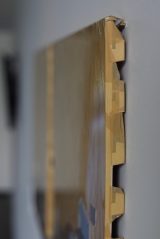 CALDER & LAWSON GALLERY
CALDER & LAWSON GALLERY
Academy of Performing Arts, University of Waikato
Raised Voices/2 July – 10 August, 2012/Curated by Karl Chitham
White meets grey tiled floors, with light sectioned through the space by way of glass doors at both ends and windows above. Immediately, the Calder & Lawson Gallery strikes me as a strange space to define as a gallery as, at first glance, it could be easily passed through, mistaken for a foyer-like space leading to the reception desk further ahead on my right. However, stickered text immediately on my left explains that I am in the right place, while also introducing me to the information on the current exhibit – Raised Voices.
For this particular exhibit, the display of work is balanced, clean and simple. The white I had initially registered (and that I had assumed  was caused by the colour of the walls) is not actually white, but slightly off, allowing for a subtle distinction to be made between the white frame of those works that are framed, and the colour of the walls from which they hung.
was caused by the colour of the walls) is not actually white, but slightly off, allowing for a subtle distinction to be made between the white frame of those works that are framed, and the colour of the walls from which they hung.
 Not all of the works are framed. Two flat screen televisions display the audiovisual works present; and two pieces by Eve Armstrong appear to be inappropriate for framing, due partly to their substa
Not all of the works are framed. Two flat screen televisions display the audiovisual works present; and two pieces by Eve Armstrong appear to be inappropriate for framing, due partly to their substa nce being made up of recycled rubbish, the result of which (at least I thought) has more impact out in the open, rather than being separated from the viewer by glass.
nce being made up of recycled rubbish, the result of which (at least I thought) has more impact out in the open, rather than being separated from the viewer by glass.
The works that are framed are the photographs in the exhibit. The frames, and the even spacing between them defines the limits of the relevant image enough so as to  guide the viewer’s eye within the intended space for each individual piece, without being intrusive or utterly restrictive. Spotlights hung from a center beam also softly illuminate the works. For the larger photographic pieces at least, two spotlights appear to be focused upon each individual piece, but the lighting is gentle, hardly producing a shadow, working to emphasize the direction for the viewer described above.
guide the viewer’s eye within the intended space for each individual piece, without being intrusive or utterly restrictive. Spotlights hung from a center beam also softly illuminate the works. For the larger photographic pieces at least, two spotlights appear to be focused upon each individual piece, but the lighting is gentle, hardly producing a shadow, working to emphasize the direction for the viewer described above.
The works I felt most drawn to were the constructed photographs by Yang Yi. The context of his work is intriguing, with shards of playfulness and light just peering through dark images of gloom, helplessness and loss. In terms of layout design, these prints were also quite large (as well as being hung at eye level and evenly spaced across the wall) which added to the impact of their depiction. I did find it unusual, however, standing directly in front of these framed images, and noticing the reflection of myself, and of the works on the wall behind me, in the glass. My eye had to move past the reflective glass to get to the image itself. Perhaps this, in its own way, adds to the impact  of the works, but personally I found it to be a little irritating. This will be an aspect that I will take note of at other exhibit spaces, to see if there is any attempt to work around this, if a way is even possible with framed works, or if work is simply not framed at all, and therefore (intentionally or not) avoids this altogether.
of the works, but personally I found it to be a little irritating. This will be an aspect that I will take note of at other exhibit spaces, to see if there is any attempt to work around this, if a way is even possible with framed works, or if work is simply not framed at all, and therefore (intentionally or not) avoids this altogether.
